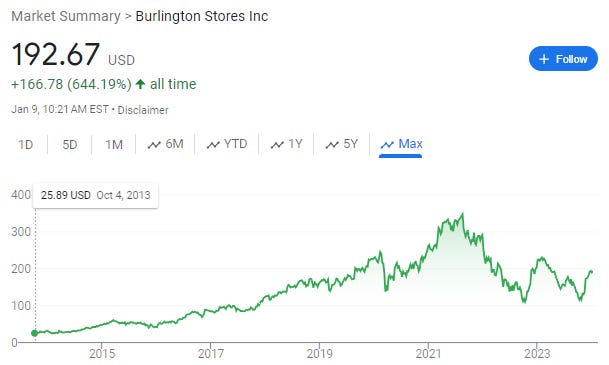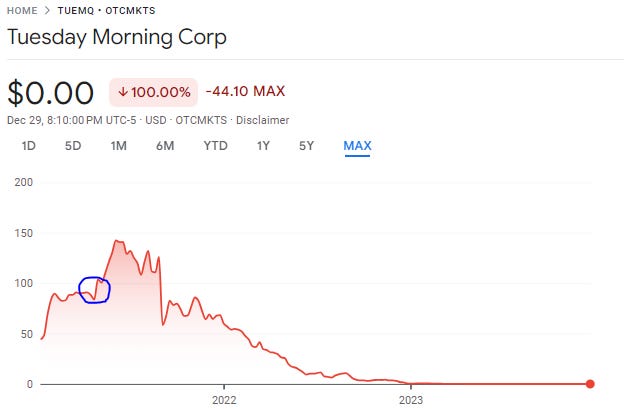Tuesday Morning (TUEM) Case Study
Why Following People On the Long Side is Harder Than the Short Side
Dear OpTrackers,
Today we’re going to do a historical look back at what I consider to be a very instructive historical example of investing based on following good people. In this post we’re going to cover a lot of ground in two parts. First, we’ll look at what happened at TUEM and lessons that can be learned from it. And second, we’ll take those lessons and discuss why following executives from company to company may be more fruitful for shorts than longs (which also helps explain why I am 12 specific idea write-ups into this blog and there have been 10 shorts and 2 longs!).
Tuesday Morning Case Study
Company Background
Tuesday Morning (“TUEM”) is/was an off-price bricks-and-mortar retailer. It was founded in 1974 and the business model was basically buying liquidation inventory from brand name manufacturers and then selling them out of a warehouse for heavily discounted prices. This eventually grew and turned into an 800-unit chain of stores that did the same thing.
One thing leads to another, retailing is very hard, COVID is a huge impact to brick-and-mortar retailers, etc. and the company was forced into bankruptcy in 2020. As part of the bankruptcy process they were able to rightsize the cost structure in many ways. 200 stores were closed, the majority of remaining leases were renegotiated, their distribution infrastructure was rightsized, and corporate costs were slashed.
Equity holders got to keep a small part of the pro forma company. Osmium Partners owned 30%+ of the company at exit, which is important because we’ll talk about them again with respect to the thesis and how they helped incentivize the key people.
TUEM Investment Thesis / People Angle
Shortly after the bankruptcy exit, TUEM would have looked like an incredibly attractive investment opportunity from the perspective of following the key people. TUEM assembled what looked like a whose-who line-up of off-price retailing talent from Burlington (“BURL”). Burlington is a national chain of off-price brick-and-mortar retail stores and the stock has performed exceedingly well over time.
The first big hire was Paul Metcalf, who was the CMO of Burlington until March 2015. He would go on to join TUEM in April 2019 as Acting Chief Merchant. He was regarded as “the guy” at Burlington and if you see the stock dip around March 2015, that’s the exact time Paul left the company, so the market viewed him leaving as a big deal. You’ll note that Paul joined TUEM ahead of the bankruptcy discussed above, but given the short time frame between him joining and the filing plus the timing of COVID, I don’t think that bankruptcy should have tarnished his reputation. That one probably isn’t his fault.
Paul then presumably called his former colleague, Fred Hand, then-COO of BURL, to explain what a great opportunity TUEM is post-bankruptcy. He also apparently did a pretty good job because Fred leaves BURL to become the CEO of TUEM in May of 2021.
And then the final piece of the leadership puzzle gets put into place 2 weeks later when these two recruit BURL’s former CFO, Marc Katz, to join TUEM as its CFO.
So, in May of 2021, TUEM looks like an incredibly interesting setup. You have a newly cleaned up company due to the bankruptcy process. And the three most important executive roles at the company have been turned over with the new guys have prior experience or directly leaving very cushy jobs at a successful multi-billion dollar company in the same industry, collecting multi-million dollar compensation packages, to join a $300mm market cap company. These guys were taking serious career and financial risk to bet on TUEM.
Furthermore, as the cherry on top, Osmium Partners did something I have never seen before. Part of the CEO’s new compensation package was 30% of the carried interest in the SPV that held Osmium’s position in the company. The management alignment with shareholders here could not be better. It’s a buyside analyst’s wet dream.
How Did It End Up?
I will spare you the nitty gritty details of the play-by-play, but this story doesn’t end well. Here is TUEM’s stock chart since it exited the first bankruptcy. The blue circle is about where the CEO and CFO join the company.
There really wasn’t anything exciting that happened. The new management team was running a turnaround playbook at a post-reorg company and the turnaround just never worked. If you ignore the initial pop from the headlines of the new team being brought on, the stock pretty much went down in a straight line.
Key Takeaways
I think this is a very instructive example to learn from as we focus on people-driven investments. As always, the lesson here has already been pithily covered by Warren Buffett:
“When a management with a reputation for brilliance tackles a business with a reputation for poor fundamental economics, it is the reputation of the business that remains intact.”
Generating superior shareholder returns is just hard. Many of you may be familiar with the work of Bessembinder at ASU who analyzed long-term equity returns and concluded that most stocks do not outperform treasury bills. The median stock has a negative total shareholder return over the long-term. On the long side, it’s not enough to get the people right, you have to get the business and the entry valuation right as well. Yes, a good management team will dramatically outperform a bad management team running an identical business - but even Jeff Bezos, Mark Zuckerberg or Satya Nadella couldn’t have created great outcomes selling buggy whips in the time of the automobile.
Why People Tracking is Harder on the Long Side
Many great executives stay at a single company for a long time, just look at the three names I mentioned above - Bezos, Zuckerberg, and Nadella.
It’s harder to get conviction someone is truly a great operator without results from multiple roles
As described above, the base rates are working against you - the life-time returns of most stocks is negative
Getting the business/industry right is also important, and just harder
Why People Track Is More Effective on the Short Side
I believe there is more of a virtuous cycle in terms of following “bad” people on the short side.
Executives with poor track records will likely find it harder to get an important role at a great company. So companies with “bad” people are more likely to be “bad” companies to begin with
As we just described, most companies aren’t great companies, so the ones that are can be choosier with whom they hire and they’re likely to pick someone with a great track record.
Poor executives are likely to turnover more and thus it’s easier to accumulate overwhelming evidence of poor aptitude
Companies driven to bankruptcies/liquidations forced the executive teams to find new roles at new companies
Poor executives that deliver poor performance are more likely to be fired and thus have to find new roles at new companies
It’s easier to be involved with multiple companies at the same time if you’re phoning it in or running more of a stock promotion than a real business
The base rates are working for you. As long as you don’t size positions so large you’ll be forced to cover if it moves against you, odds are any individual stock you short will eventually be lower.
A bad management team can overwhelm positive company/industry fundamentals more easily than a good management team can overcome back company/industry fundamentals
So there we have it. For all of these reasons I think going forward I will continue to skew more heavily towards shorts than longs, but I will try to make sure we maintain a healthy mix. And on the long side I will be sure to try to cover the bases on the company/industry as well as the executives to avoid potential big mistakes like TUEM.
If you enjoy the content please smash the share and subscribe buttons below. It means the world to the me!
Disclaimer: As always please remember nothing written in this blog should be considered investment advice. You should assume that even though we tried our best that this post is riddled with errors and do your own research/consult a licensed financial advisor before investing any of your own money into any financial security






